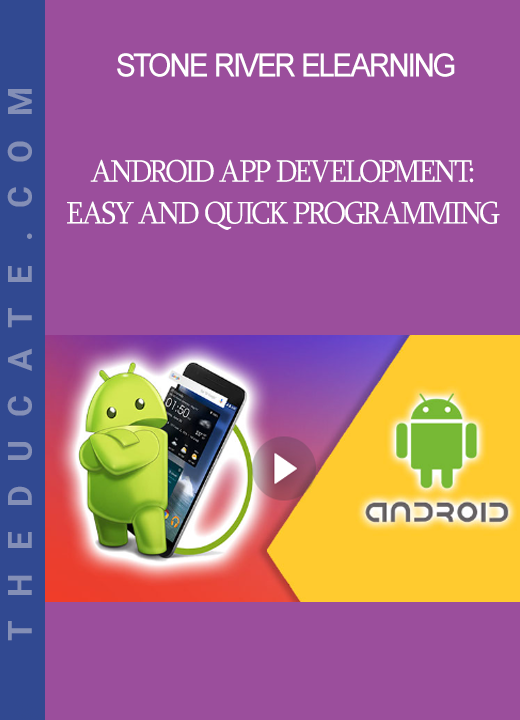Description
Stone River Elearning – Android App Development: Easy and Quick Programming
Become an Android Developer on mobile
Once upon a time, iOS app developers were the ones in demand. Now the mobile world has busted wide open and Android is a fierce rival, not to mention a truly exciting area to dive into. App development is advancing at a rapid pace and there’s always something new and innovative being produced somewhere. With this course, you can jump right in and get involved yourself; who knows, maybe the next must have Android app will be one of your own creations!
Quick, Easy Programming
- Create, test and run Android apps
- Learn the ins and outs of Android Studio
- Gain a solid skill set applicable to all app development projects
- Get practical, hands on experience in building mobile apps
- Pick up the latest changes in the newest version of Android
Learn Android App Development from a Beginner’s Perspective
This course has a whopping 119 lectures and 9 hours of content; enough to take you from zero to Android app hero in no time. If you have a basic understanding of the Java programming language and an interest in app development, you’ll be the perfect student.
The course s off by introducing you to all essential software you’ll need (namely, Android Studio), and will take you through the installation process. Once that’s done you’ll go through all of the essential Android components, learning how they work to build up a foundation of knowledge. From there, you’ll get ed with hands-on experience by creating your own practical Android app.
You’ll demonstrate the concepts you’ve just learned and put your new found skills to the test by building an app from to finish, complete with database creation, fragment management, custom array adapters, Android preferences and more. By the time you’re finished, you’ll be a verified Android app expert.
Tools Used
Android Studio: Android Studio is the official Interactive Development Environment (IDE) for Android app development. It’s used by all Android developers and, despite its complexity and power, is relatively easy to pick up once you have some background knowledge.
* This course was published in January 2016 and teaches the most up to date operating system and development tools available.
Course Curriculum
1.Introduction to the Course
- Course Introduction (1:29)
- Brief Android Overview (6:23)
- Final Project Demo (4:44)
- Section Introduction (0:22)
- Installing The Java Development Kit (3:03)
- Downloading And Installing Android Studio (4:07)
- Adding Sdk Tools, Packages And Platforms (6:52)
- Section Conclusion (0:26)
- Section Introduction (0:43)
- Configuring New Projects P1: Application Name, Package Name, Project Location (2:33)
- Configuring New Projects P2: Targeted Device; Android SDK’s (3:33)
- Configuring New Projects P3: er Activities (1:46)
- Configuring New Projects P4: Activity Customization (3:58)
- Activities (4:32)
- Manifest File (2:45)
- Build.gradle File (5:31)
- Res directory: drawable folder (3:59)
- Res directory: layout folder (1:36)
- Res directory: menu folder (1:31)
- Res directory: values folder (3:04)
- Section Recap (0:37)
- Section Introduction (0:30)
- Setting Up (Physical) Android Phone (5:12)
- Setting Up Emulator (7:49)
- Running App Via Device or Emulator (3:51)
- Android Tool Window (5:56)
- Section Recap (0:20)
- Section Introduction (0:18)
- Views & View Groups (3:42)
- Introduction To Layouts Editor / Visual Designer (6:06)
- Breaking Down Android Layouts (9:13)
- Introduction To Widgets (7:16)
- Defining Layout Text With The String Resource File (2:38)
- Brief Overview Of Android Dimensions (3:04)
- Creating Additional Layouts With Android Studio (3:55)
- Section Recap (0:28)
- Section Introduction (0:28)
- The Activity Lifecycle (4:16)
- Settings Layouts And Accessing UI elements From Activity (6:27)
- Creating Additional Activities With Android Studio (3:07)
- Creating Additional Activities Without Android Studio (5:45)
- Section Recap (0:26)
- Section Introduction (0:20)
- Intent Overview (4:53)
- ing New Activities With Intents (5:07)
- Sending Data To Other Activities (4:08)
- Receiving From Another Activity (6:42)
- Creating Implicit Intents (7:35)
- Section Recap (0:21)
- Section Introduction (0:23)
- Creating Notebook Application (4:45)
- Breaking Down Newly Created Project Part 1 (7:38)
- Breaking Down Newly Created Project Part 2 (10:19)
- Implementing The Main Activity Listfragment (9:25)
- Breaking Down Fragments (9:05)
- Section Recap (0:24)
- Section Introduction (0:18)
- Application Roadmap Part 1 (1:27)
- Demonstrating Simple ArrayAdapter (6:48)
- Implementing Custom ArrayAdapter Part 1 : Creating Row Layout (10:35)
- Implementing Custom ArrayAdapter Part 2 : Creating Note Data Structure (8:36)
- Implementing Custom ArrayAdapter Part 3 : Creating NoteAdapter (9:56)
- Implementing Custom ArrayAdapter Part 4 : Finalizing And Filling Note List (8:15)
- Implementing Custom ArrayAdapter Part 5 : Optimizing NoteAdapter (8:29)
- Section Recap (0:21)
- Section Introduction (0:23)
- Application Roadmap Part 2 (1:48)
- Creating NoteDetailActivity (3:09)
- ing NoteDetailActivity Via Intent (7:12)
- Adding NoteViewFragment Part 1 : Creating The Fragment (1:07)
- Adding NoteViewFragment Part 2 : Creating The Layout (8:22)
- Adding NoteViewFragment Part 3: Populating Layout With Received Note Data (8:33)
- Dynamically Loading NoteViewFragment (10:27)
- Section Recap (0:24)
- Section Introduction (0:32)
- Application Roadmap Part 3 (2:41)
- Creating ListFragment Context Menu Part 1 : Adding Menu layout (4:58)
- Creating ListFragment Context Menu Part 2 : Implementing Menu Layout (7:22)
- Adding NoteEditFragment Part 1 : Creating The Fragment (1:19)
- Adding NoteEditFragment Part 2 : Creating The Layout (10:09)
- Adding NoteEditFragment Part 3 : Populating Layout With Received Note Data (8:15)
- Dynamically Adding And ing Noteeditfragment Part 1 (10:55)
- Dynamically Adding And ing Noteeditfragment Part 2 (8:10)
- Section Recap (0:21)
- Section Introduction (0:22)
- Creating AlertDialog Box (9:47)
- Implementing Category Button OnClickListener (5:49)
- Creating AlertDialog Confirmation Box (10:32)
- Implementing Save Button OnClickListener (7:38)
- Retaining Information On Orientation Change With OnSaveInstanceState (9:07)
- Section Recap (0:36)
- Section Introduction (0:32)
- Application Roadmap Part 4 (1:26)
- Adding New Note Item To Action Bar Part 1 : Updating Action Bar Layout (5:06)
- Adding New Note Item To Action Bar Part 2 : Receiving Action Bar Selection (5:02)
- Modifying NoteEditFragment For Note Creation (6:11)
- Fixing New Note Bug Part 1: Sending Data To Fragments (4:51)
- Fixing New Note Bug Part 2: Retrieving Data In Fragments (6:01)
- Section Recap (0:30)
- Section Introduction (0:30)
- Creating And Defining Our Database (10:56)
- Getting Help From SQLiteOpenHelper (8:41)
- Reading Notes From Our Database Part 1: Implementing Database Methods (12:32)
- Reading Notes From Our Database Part 2: Using Database Methods (3:33)
- Creating New Notes In Our Database Part 1: Implementing Database Methods (7:04)
- Creating New Notes In Our Database Part 2: Using Database Methods (7:32)
- Updating Preexisting Notes (8:11)
- Deleting Notes (7:15)
- Section Recap (0:33)
- Section Introduction (0:32)
- Application Roadmap Part 5 (0:54)
- Creating Preference Fragment Layout (6:52)
- Creating Preference Fragment & Activity (5:43)
- ing & Tweaking Preference Activity / Fragment (3:46)
- Retrieving Application Preferences (5:21)
- Section Recap (0:16)
- Course Recap And Next Steps (3:16)
- Additional Resources (3:38)
- Closing Message (0:40)
Sale Page: https://stoneriverelearning.com/p/android-app-development-easy-and-quick-programming
Archive: https://archive.ph/9aWtF







Reviews
There are no reviews yet.